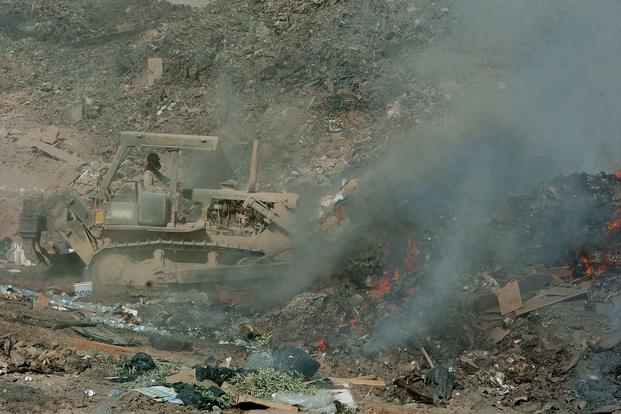The Department of Veterans Affairs is increasing its focus on health conditions linked to burn pits and other airborne pollution in combat zones, establishing a "center of excellence" to better understand the extent of related illnesses and treatments for affected veterans.
The new Airborne Hazards and Burn Pits Center of Excellence was stood up in May at the VA's War-Related Illness and Injury Study Center, or WRIISC, in East Orange, New Jersey. The office will specialize in clinical and translational research, as well as forging partnerships with researchers, physicians and others currently working to support veterans with burn pit-related diseases.
According to Dr. Anays Sotolongo, the center's director, the facility's mission is multipronged: It will work to understand the health consequences of airborne environmental exposures, provide health evaluations for difficult-to-diagnose patients, build a network of specialized clinicians across the country, and facilitate research.
"We are forming collaborative partnerships with the Department of Defense, with academic partners and others to better understand the spectrum of diseases, health outcomes and treatments ... and we want to serve as a resource for providers seeing veterans all over the country," Sotolongo told Military.com.
The center was created last September by Congress as part of the legislation that funds the VA. It builds on an existing center of excellence -- the Airborne Hazards Center of Excellence -- and includes $10 million in additional funds over the next year to study burn pit-related health conditions.
When fully manned, the center will have at least 18 employees, including pulmonologists, occupational medicine physicians, technologists, researchers and more, Sotolongo said. An in-house analyst will study data contained in the VA Airborne Hazards and Open Burn Pit Registry, which contains information from 173,000 veterans who served in the Middle East starting with the first Gulf War and Afghanistan and Djibouti after Sept. 11, 2001.
Burn pits were used in Iraq, Afghanistan and elsewhere to dispose of waste generated by the deployment of millions of troops. Items including household trash, hospital waste, plastic bottles and drums, furniture, lithium ion batteries, computer parts, animal carcasses, insecticide-soaked tents and uniforms were burned in large open pits.
At their peak, burn pits numbered 22 in Iraq and 251 in Afghanistan. Nine remain in operation.
Service members who lived and worked at or near the pits described developing illnesses, including asthma, bronchitis and skin infections, shortly after landing in theater.
Later, returning service members reported continuing health problems, including asthma and difficulties taking deep breaths. A number have been diagnosed with a rare lung condition called constrictive bronchiolitis, while some have other heart and lung conditions thought to be related to burn pits.
The new center of excellence will focus on cardiopulmonary conditions thought to be linked to burn pits, Sotolongo said, adding that lung and heart problems make up the highest number of symptom complaints in the burn pit registry.
"We're focusing on that. It's sort of our low-hanging fruit," she said.
Respiratory issues, however, are far from the only conditions burn pits may have caused. Many troops have developed cancers -- some rare -- they believe are related to exposure. In 2006, Air Force Lt. Col. Darrin Curtis, a bioenvironmental flight commander at Joint Base Balad in Iraq, said a number of cancer-causing agents, such as benzene, formaldehyde and xylene, were released into the air from the pits.
"We have to start somewhere so we decided to start with cardio-pulmonary. But Phase Two, absolutely, we are looking to assess cancer risk, any sort of cognitive dysfunction. Veterans are saying they are having issues with processing and whether that's related to burn pits, we will be looking at that as well," Sotolongo said.
While Congress created the center by legislative fiat, the center actually grew out of the work of the War Related Illness and Injury Study Center (WRIISC), which conducts comprehensive, four-day evaluations of the VA's most complex deployment-health cases, Sotolongo said.
Veterans coming to the center often reported that they had chronic breathing issues, couldn't catch their breath or had no energy after returning home from overseas. Physicians at the WRIISC focused on pulmonary conditions long before the center of excellence was established, she said.
"We would like veterans to know that we are listening to them, that we will be including their voices as we evolve. We understand the veterans have been experiencing many of these symptoms for a while, but we are a new center and ... we will be listening to what they have to say," Sotolongo said. "Our research and our clinical exploration is really guided by their voices."
The WRIISC sees veteran patients by referral from their VA primary care and specialty physicians and also provides consultations to veterans through their home VA medical centers.
More information on the Airborne Hazards and Burn Pits Center of Excellence and the WRIISC, can be found on their websites.
-- Patricia Kime can be reached at Patricia.Kime@Military.com. Follow her on Twitter at @patriciakime.












